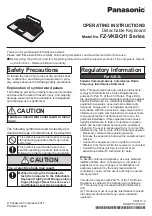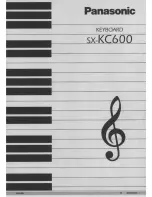
17
Your RP301R contains a function that plays back automatic
accompaniments called “rhythms”. It generates interactive
accompaniments based on the Rhythm you select. Each Rhythm
is a typical accompaniment for a given musical genre. The RP301R
comes with internal rhythms divided over 11 families (“A”~“K”).
Unlike a drum machine, a RP301R Rhythm not only contains
the rhythm part (drums & percussion) but also a melodic
accompaniment, such as piano, guitar, bass and strings lines. The
melodic accompaniment parts of the selected Rhythms follow the
chords you play on the keyboard.
You can also record both your playing and the accompaniment
(“Recording” on p. 21).
Structure of the Rhythm
accompaniments
Each Rhythm is comprised of several patterns:
Button
Lit/Unlit
Explanation
[Variation]
Unlit
The Rhythm function plays the simpler
accompaniment (usually with fewer
instruments).
Lit
The Rhythm function plays a more
elaborate accompaniment.
[Intro/Ending]
—
If you switch on this button (indicator
lights) while the Rhythm function is
stopped, Rhythm playback begins with
an introduction.
If you press this button while a
Rhythm is being played back (indicator
fl ashes), the RP301R starts playing a
closing phrase (“Ending”) on the next
downbeat. At the end of this phrase,
playback stops.
Note
While the two Variation patterns are repeated indefi nitely until
you stop Rhythm playback, the Intro and Ending phrases are
played only once.
The available Rhythm patterns could be used as follows:
Intro
Variation
Variation
Variation
Ending
Beginning of the song.
First verse (simple accompaniment).
Last verse (simple accompaniment).
Closing section.
First chorus (richer accompaniment).
Playing back a rhythm
Note
You can also specify that only the chords played in the left half
of the keyboard should be used for real-time transposition of
the Rhythm accompaniments. See p. 19.
1.
Press the [Rhythm] button so it’s lit.
2.
Use the [–] [+] buttons to select the Rhythm you want to
use as your accompaniment.
The RP301R’s internal memory already contains a number of
Rhythm accompaniments when it leaves the factory. These
Rhythms reside in 11 banks (“A”~“K”). If you connect a USB memory,
you will also be able to play back Rhythms of the “S” bank. “S” refers
to the USB memory. See “Playing back Songs or Rhythms on a USB
memory” (p. 22).
3.
To quickly jump to the next bank, hold down the [+]
button and press [–].
To jump to the fi rst Rhythm of the previous bank, hold
down [–] and press [+].
Depending on the bank you select, the display now looks as
follows:
Gt Beat
B001
• Rhythm numbers beginning with a letter
(“A”~“K”) are internal Rhythms.
• Rhythm numbers beginning with “S” are
Rhythms on a connected USB memory.
Note
* If the name of the selected Rhythm does not fi t in the top line, it
will scroll through the display.
* For the titles of the internal Rhythms, refer to “Internal Rhythm
list” (p. 36).
4.
If you want to start with an introduction, press the [Intro/
Ending] button (its indicator lights).
This means that Rhythm playback will start with an introduction.
When it is fi nished, the RP301R automatically jumps to the simple
or complex Variation pattern (see the next step),
5.
Switch the [Variation] button on or off to select the
complexity of the accompaniment.
6.
Press the [Start/Stop] button to start playback.
The Rhythm will begin playing.
7.
Play a few chords on the keyboard (one or two per
measure) and listen to how this aff ects the note pitches of
the accompaniment.
If the [Split] button’s indicator doesn’t light, the Rhythm function
analyzes all notes and chords you play on the keyboard and
transposes the melodic accompaniment parts accordingly.
If the [Split] indicator lights (see p. 19), only the notes and chords
played in the left half will be used for real-time transposition of the
melodic accompaniment parts.
8.
Press the [Variation] button whenever you want to make
the arrangement simpler or more complex.
The change from the simple to the complex Rhythm pattern (and
vice versa) is always performed at the beginning (“downbeat”) of
the next measure. This allows you to press [Variation] a little ahead
of where the change should occur.
9.
To stop Rhythm playback, either press [Start/Stop] again,
or press [Intro/Ending] to select the ending phrase.
&
&
Using the Rhythm function
Содержание RP301R
Страница 2: ......
Страница 3: ...r Owner s Manual...
Страница 43: ...Bedienungsanleitung r...
Страница 83: ...Mode d emploi r...
Страница 123: ...Manuale di Istruzioni r...
Страница 163: ...Manual del Usuario r...
Страница 203: ...Manual do utilizador r...
Страница 243: ...Handleiding r...
Страница 283: ...283 For EU Countries For China For EU countries For China...
Страница 286: ...5 1 0 0 0 2 8 3 2 4 0 3...
















































